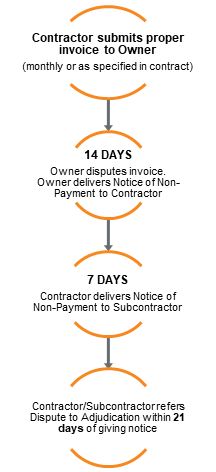With significant amendments to the Construction Act having come into force on October 1, 2019, it is critical for all members of the industry to understand how these reforms will impact their organizations, contracts, and projects.
Overview
This post is meant to provide an overview of the prompt payment and mandatory adjudication provisions of Ontario's new Construction Act (the Act), which took effect on October 1, 2019.
This second round of amendments implementing prompt payment and adjudication requires significantly more preparation by all parties involved in a project — including owners, contractors, subcontractors, lenders, architects and engineers, etc. — who should be updating their internal procedures, contract negotiation, and contract drafting to manage the new processes and risks associated with the new regime.
Which provisions of the new Act affect your project?
The related transition provisions of the Act provide that prompt payment and adjudication will not apply to prime contracts entered into before October 1, 2019. The new regime also will not apply to prime contracts entered into on or after October 1st, if a procurement process for the improvement1 that is the subject of the contract was commenced by the owner before that day. This non-application of this provision holds true regardless of when any subcontracts under the prime contract were entered into.
One way to think about the transition rules is to divide the project contract world into three relevant time periods.2 Generally speaking, if your prime contract was entered into:
- before July 1, 2018, your project is governed by the previous, pre-amendment version of the Act, being the Construction Lien Act.
- between July 1, 2018 and September 30, 2019 inclusive, your project is governed by the lien modernization provisions of the new Construction Act, but not the prompt payment or adjudication under Parts I.1 and II.1 of the new Act.
- on or after October 1, 2019, your project is governed by the new Construction Act, including the prompt payment and adjudication provisions under Parts I.1 and II.1.
Prompt Payment and Adjudication: What you need to know
Prompt payment and adjudication are closely connected. While adjudication is available for disputes related to issues other than payment, the new system is intended to ensure the contracting parties' compliance with the prompt payment timelines and notice requirements. As with the first round of amendments, parties are unable to contract out of the prompt payment and adjudication regime.
1. Prompt Payment
The prompt payment provisions impose statutory deadlines for payments to contractors and subcontractors during construction projects. The deadlines begin to run from the date of delivery of a "proper invoice" by the general contractor to the owner. In short, the owner is required to pay the contractor within 28 days of receiving a proper invoice from the contractor, who then has 7 days to pay its subcontractors after receiving payment from the owner. Prompt payment applies down the construction pyramid, with deadlines prescribed by the Act at each level.3
"Proper Invoice"
As described above, a "proper invoice" triggers the prompt payment timelines under the Act. The Act permits parties to agree on a schedule for the submission of proper invoices, but prescribes a default requirement that proper invoices be submitted monthly if the contract is otherwise silent. This means that one way for parties to control the payment timelines in their project contract is to create a milestone payment schedule for the delivery of proper invoices.
However, parties cannot make the issuance of a proper invoice contingent on certification of payment or owner's approval (except for P3 projects, and in cases of invoices for testing or commissioning). This means that owners will want to stay ahead of the deadlines and arrange for a payment certifier to review the work prior to the set date for submission of the invoice.
Payment Timelines – What happens if the invoices are paid?
Once the proper invoice is delivered to the owner, the statutory prompt payment timelines kick in. As mentioned, the parties cannot contract out of the 28-7-7 day payment deadlines that flow down the construction pyramid. Subject to the right to deliver a Notice of Non-Payment, payments must be made within those time periods. The figure below illustrates the flow of payments in a scenario where the proper invoice and all subsequent invoices are undisputed and paid.
Contractors and subcontractors will have a right to charge mandatory interest on late payments beginning when the amount is due. Interest is calculated at the prejudgment rate set by the Courts of Justice Act or a rate set out in the subcontract.

Notice of Non-Payment – What happens if an invoice is disputed?
Any party who wishes to dispute an invoice must issue a Notice of Non-Payment within the prescribed timeline. For example, an owner disputing a proper invoice must provide the contractor with a Notice of Non-Payment explaining the reasons for non-payment within 14 days from receipt of the proper invoice. The failure to issue a Notice of Non-Payment within the time period will result in the owner being required to pay the contractor the full amount within the required 28 day payment period described above.
This means that owners must be ready to implement new or shortened processes to ensure that invoice reviews can be completed before the expiry of the 14 day period.
In the case where a contractor receives full payment of a proper invoice from the owner, but disputes the entitlement of a subcontractor to payment, the cumulative effect of the timeline is that the contractor must give the subcontractor Notice of Non-Payment within 35 days after delivering the proper invoice to the owner. Similarly, if a subcontractor receives full payment from the contractor but disputes the entitlement of its subcontractor to payment, it must give Notice of Non-Payment within 42 days after the original proper invoice was delivered by the contractor to the owner.
Note that if the general contractor's reason for not paying its subcontractor is the contractor's receipt of a Notice of Non-Payment from the owner, then the contractor will be required to refer its dispute with the owner to adjudication within 21 days of its delivery of Notice of Non-Payment to the subcontractor. If a contractor does not itself issue a Notice of Non-Payment to its subs where it has not been paid by the owner, it will be obliged to pay its subcontractors.

2. Mandatory Adjudication4
The amendments to the Act established an interim dispute resolution process that is temporarily binding on the parties. That is, an adjudicator's determination will remain binding unless and until the same issue is later determined by a Court or in arbitration.5 The process is intended to encourage the efficient resolution of disputes during a project, and is expected to significantly alter the scheme for construction dispute resolution in the province.
Adjudication is available while the project is on-going for disputes related to the valuation of services materials, payment, disputes regarding a Notice of Non-Payment, set off claims, the payment or non-payment of holdback, labour and materials bonds, and any other matters the parties agree to adjudicate. The parties' ability to appeal an adjudicator's determination through judicial review will be extremely limited.6 As a result, the parties will in all but the rarest of circumstances be required to comply with an adjudicator's determination. At the same time, the parties will be permitted to provide for a dispute resolution process in their contract provided that the contractual process is consistent with the legislation. In addition, contractors and subcontractors continue to have the right to file a lien action in the court under the current process.7
The key features of the adjudication process under the Act and adjudication regulation include:
- Any party to a contract or subcontract may refer a dispute to adjudication by delivering a written Notice of Adjudication setting out the particulars of the dispute.
- Disputes will be heard by an adjudicator from the registry of adjudicators, who may be selected by the parties or by the Authorized Nominating Authority (ANA) (discussed below). If the adjudicator selected by the parties does not consent to adjudicate within 4 days of delivery of the Notice, the referring party must request that the ANA appoint an adjudicator. Upon receiving a request for appointment, the ANA must appoint an adjudicator within 7 days.
- The parties and the adjudicator may agree to the fees of the adjudicator. If they do not agree, the fees will be determined by the ANA in accordance with a fee schedule published on the ANA's website.
- After an adjudicator is appointed, the referring party must provide their documents for adjudication with a copy of the Notice to the adjudicator and the responding party within 5 days. The responding party must submit any response to the adjudicator and referring party on the same day within the timelines prescribed by the adjudicator.
- The adjudicator must issue a determination within 30 days of receiving the referring party's documents (or within a time period agreed to by written consent of both parties and the adjudicator).
- The determination will be binding on the parties, on an interim basis, until the dispute has finally been resolved in court or arbitration, or by agreement of the parties. If no litigation or arbitration is pursued, the determination will be final.
- If the party owing money refuses to pay within 10 days of the adjudicator's determination, the party that is owed the money has the right to: stop work under the contract, charge mandatory interest on late payments, claim for demobilization and remobilization costs once paid, and/or enforce the adjudicator's determination by filing a certified copy in the Superior Court of Justice, which then has the force of a court order.
Considering the short adjudication timelines, the binding nature of the decisions, and limited appeal rights, industry parties should consider how to manage their internal processes to be ready in the event of a dispute.
The Authorized Nominating Authority
A key component of the new adjudication regime is the creation of the Authorized Nominating Authority (the "ANA"), the independent body that provides adjudication services and oversees the process under the Act and regulation.
The Ontario Dispute Adjudication for Construction Contracts ("ODACC") of ADR Chambers has been selected as the ANA, and is tasked with developing and overseeing training for adjudicators; qualifying individuals who meet the prescribed requirements as adjudicators; maintaining a fee schedule, a code of conduct for adjudicators, and a complaints procedure; appointing an adjudicator to a dispute, if required or requested by the parties; and publishing educational materials and an annual report containing aggregated information regarding adjudication in Ontario.
The ODACC's website is now up and running with resources for claimants, respondents, and adjudicators.
Key Takeaways and Practical Considerations
The changes that came into force on October 1, 2019 are substantive and will materially affect the industry and how payments are made and payment disputes are resolved. Some practical considerations for industry members include:
- Consider having "pre-invoice confirmations" so as to have information regarding payment requests in advance of the formal issuance of a proper invoice;
- Use milestone payments where appropriate which can provide for additional time for invoice review;
- Arrange for payment certifier review of work ahead of date for submission of invoice.
- Be ready for a dispute: A Written Notice of Adjudication will start the clock so consider the timing / manner of response. For example:
-
- A payer should start the collection of documents, consider the need for witnesses or experts as soon as a payment dispute appears to be brewing, so as to be ready to respond to a payment issue as soon as a Notice is issued.
- Consider contractual dispute processes, which can agreed to provided they are not inconsistent with the interim adjudication process. For example, a pre-referral negotiation process can be agreed to in the contract which would provide time to discuss resolution prior to the clock starting on an adjudication.
- The Act requires that a decision be issued within 30 days of submission of documents, unless an extension is granted. Pre-agreement to extensions for disputes above a certain threshold can be considered and jointly requested of the adjudicator to provide for more time for the adjudication steps.
Clients should be sure to understand how Ontario's new Construction Act will affect their projects.
Footnotes
1. Under the Construction Act, a "contract" is an agreement entered into directly with a project owner for an "improvement".
2. Refer to Section 87.3 of the Construction Act for the transition rules and ensure that you understand how these rules apply to your situation.
3. See Part I.1 of the Construction Act, which sets out the rules for Prompt Payment.
4. See Part II.1 of the Construction Act, which provides the general scheme for Construction Dispute Interim Adjudication.
5. An issue may be referred to interim adjudication even if already the subject of an action or arbitration, provided that no determination has yet been made in such proceedings.
6. Judicial review is only available with leave from the Divisional Court, with the Court's power of review limited to bias, fatal flaws, process, and jurisdictional grounds. In addition, there is no automatic stay of an adjudicator's determination pending judicial review. Accordingly, parties will want to carefully consider the cost and potential for the issue to become moot due to the passage of time before commencing a judicial review.
7. The new Construction Act extends the time preservation of a lien, if the matter that is subject of a valid lien is also the subject of an adjudication. In such circumstances, the lien is deemed to have expired on the later of (i) 60 days from the standard trigger date for preserving a lien; and (ii) 45 days from the day the adjudicator receives the documents for adjudication. Parties should consider the impact of this provision on other provisions and deadlines in the Act, as it remains to be seen how these processes will interact.
To view original article, please click here.
The content of this article is intended to provide a general guide to the subject matter. Specialist advice should be sought about your specific circumstances.





